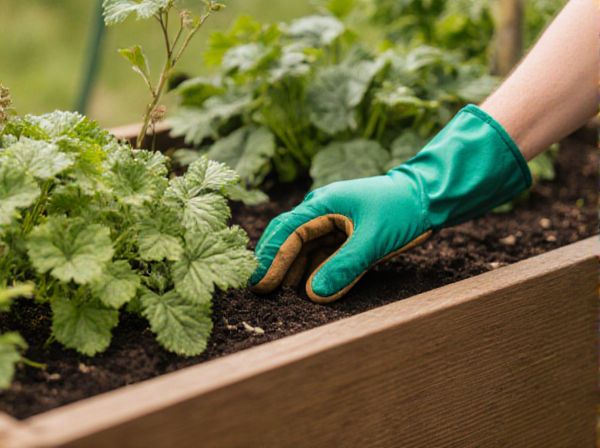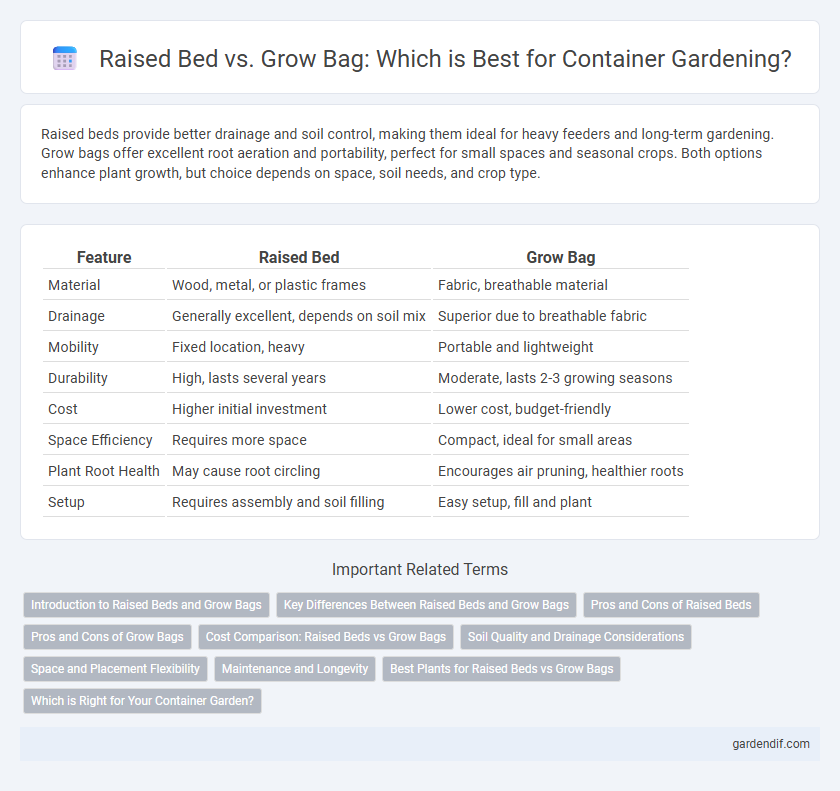
Raised Bed vs Grow Bag Illustration
Raised beds provide better drainage and soil control, making them ideal for heavy feeders and long-term gardening. Grow bags offer excellent root aeration and portability, perfect for small spaces and seasonal crops. Both options enhance plant growth, but choice depends on space, soil needs, and crop type.
Table of Comparison
| Feature | Raised Bed | Grow Bag |
|---|---|---|
| Material | Wood, metal, or plastic frames | Fabric, breathable material |
| Drainage | Generally excellent, depends on soil mix | Superior due to breathable fabric |
| Mobility | Fixed location, heavy | Portable and lightweight |
| Durability | High, lasts several years | Moderate, lasts 2-3 growing seasons |
| Cost | Higher initial investment | Lower cost, budget-friendly |
| Space Efficiency | Requires more space | Compact, ideal for small areas |
| Plant Root Health | May cause root circling | Encourages air pruning, healthier roots |
| Setup | Requires assembly and soil filling | Easy setup, fill and plant |
Introduction to Raised Beds and Grow Bags
Raised beds are structured garden containers built above ground level, typically using wood, stone, or metal, providing better soil drainage and root aeration. Grow bags are flexible fabric containers designed for plant growth, promoting air pruning of roots and improved oxygen flow. Both options enhance container gardening by optimizing root health and soil conditions for various crops.
Key Differences Between Raised Beds and Grow Bags
Raised beds offer structured, reusable gardening space with superior soil control and drainage, supporting deeper root growth and larger plants. Grow bags provide flexible, portable containers that improve aeration and prevent root circling but may require more frequent watering and limited soil volume. Key differences include durability, root development potential, and maintenance needs, with raised beds suited for long-term gardening and grow bags ideal for mobility and space-saving.
Pros and Cons of Raised Beds
Raised beds provide excellent soil drainage and improved root aeration, making them ideal for growing a variety of plants in controlled conditions. They offer durability and can be customized in size and depth, but they require more initial setup time and cost compared to grow bags. Elevated structure also helps reduce weed growth and soil compaction, though they may limit portability and flexibility in garden layout.
Pros and Cons of Grow Bags
Grow bags offer excellent aeration and drainage, promoting healthy root growth and preventing soil compaction, which helps plants thrive in container gardening. Their lightweight and flexible nature makes them easy to move and store, although they may dry out more quickly than raised beds, requiring more frequent watering. Durability can vary, with some grow bags breaking down after several seasons, which contrasts with the long-lasting structure of raised beds.
Cost Comparison: Raised Beds vs Grow Bags
Raised beds generally involve higher initial costs due to lumber, soil, and construction materials, typically ranging from $50 to $200 depending on size and quality. Grow bags offer a more affordable alternative, often priced between $5 and $20 per unit, with no extra setup costs and lightweight portability. Long-term maintenance and soil replacement costs tend to be lower for grow bags, making them cost-effective for small-scale or seasonal gardening.
Soil Quality and Drainage Considerations
Raised beds offer superior control over soil quality by allowing gardeners to customize soil composition and maintain nutrient density, essential for optimal plant growth. Grow bags provide excellent drainage due to their breathable fabric, which prevents waterlogging but may require more frequent watering to maintain consistent moisture levels. Both methods improve root aeration compared to traditional pots, but raised beds excel in soil retention and amendment flexibility.
Space and Placement Flexibility
Raised beds offer a stable, defined growing area ideal for larger spaces with permanent placement options, promoting better soil structure and root development. Grow bags maximize space utilization by providing flexible, lightweight containers that can be easily moved or rearranged to suit changing sun exposure or seasonal needs. This flexibility enables urban gardeners and limited-space growers to optimize plant placement for maximum growth without the constraints of fixed beds.
Maintenance and Longevity
Raised beds offer low maintenance with durable materials like wood or metal that can last over 10 years, requiring occasional soil replenishment and weed control. Grow bags demand more frequent watering and soil replacement due to limited soil volume and faster drying but provide flexibility for seasonal use. Overall, raised beds provide a longer-lasting, low-maintenance option, while grow bags suit short-term or mobile gardening needs.
Best Plants for Raised Beds vs Grow Bags
Herbs like basil, parsley, and thyme thrive in raised beds due to better soil drainage and root space, while grow bags are ideal for tomatoes, peppers, and strawberries that benefit from controlled soil moisture and portability. Root vegetables such as carrots and radishes perform well in raised beds because of the loose, deep soil which aids root expansion, whereas leafy greens like lettuce and spinach prefer grow bags for quick harvest cycles and easy movement. Both container types support different plant needs, making raised beds suitable for deep-rooted, space-demanding crops and grow bags perfect for plants requiring flexible growing conditions.
Which is Right for Your Container Garden?
Raised beds provide superior soil control, improved drainage, and greater root space, ideal for long-term container gardening with larger plants. Grow bags offer portability, aeration benefits, and ease of storage, perfect for small spaces or seasonal crops. Choosing between a raised bed and grow bag depends on available space, plant type, and gardening goals.
Raised Bed vs Grow Bag Infographic

 gardendif.com
gardendif.com